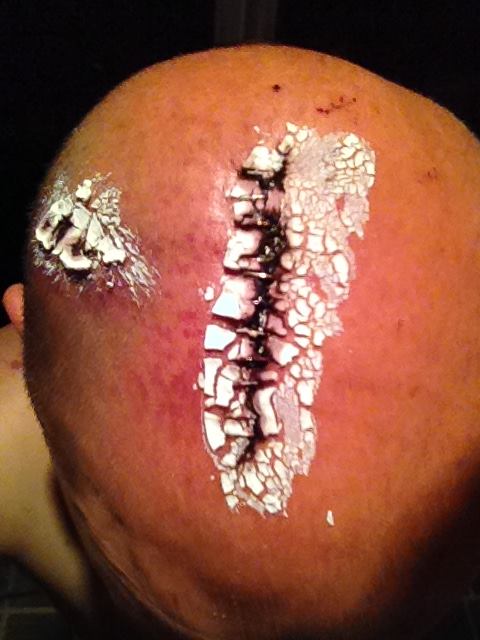

Towards the end of your visit to our clinic, your medical attendant will give you an overview, an invoice and some instructional material may be given.Ĥ. This might consist of non-prescription items or a medical prescription.ģ. Your medical practitioner will examine your medical background, go over your medical issues, perform an examination and supply you with an individualized plan for treatment. Stop by our front desk to visit a certified Nurse Practitioner or Physician Assistant. What you can expect when you visit our clinicsġ. In some cases the bandage can be removed after 24. You may have to visit your doctor again if asked for review. Check with your doctor about how long you need to keep your wound dry.If your hair and the staples are covered by dried blood, you might want to use peroxide to remove it. Hence, you can mix it with water in 1:1 proportion. Hydrogen peroxide might be too harsh on the wound.
#Stapled head wound how to#
Your doctor will then tell you how to take care of your wound and may provide you with a summary of the procedure and educational literature. Do this gently with some notes: Use saline solution, hydrogen peroxide, or soap and water to clean the wound.In the absence of any infection and proper healing of the wound, your doctor will gently and carefully remove them.After you get to the hospital or a clinic, tour doctor will take a look at your medical history and conduct an examination of your stitches or staples.Leaving them in place longer would create an unnecessary scar. When the wound has healed enough, the stitches or the staples need to be removed.What to expect at the removal of staples and stitches. The Staples are made out of stainless steel. Wounds on hands, feet, neck and face are not usually closed using staples. The locations that favor stapling are arms, legs, abdomen, scalp and the back. It generally costs more than the sutures. The staples are quicker to place and has lower chances of infection and tissue reaction. It is mostly used to stitch subcutaneous tissue. Absorbable threads are absorbed into the tissue eventually after it looses its strength.
#Stapled head wound skin#
They are usually used on the skin to be removed when the wound has healed enough.
#Stapled head wound Activator#
Squeeze the handle or activator on the stapler and a staple will be inserted into the skin. The depth of staple placement depends on how hard you press the stapling device against the skin. The non absorbable variety may last in the body for months and years. Line up the center of the laceration with the center of the head of the stapler. There are absorbable and non-absorbable suture threads. The two main parts in the suturing materials are the thread and the needle. There are many materials and technique used depending on the tissue and the injury. Sutures or stitches are the most common methods of wound closure. Sutures and staples are the two most commonly used methods. The method used for wound closure depends on the type and depth of the injury, the location and the tissue involved. Such wounds need to be closed to promote healing.

If you still have questions about this I think the best person to ask is a doctor.The tissues like skin, muscles fat and such might incur accidental injuries like in a cut or an accident or intentional injuries as in a surgery. However I want to add I am not a doctor I’m an engineer, I don’t have medical training. So I think this is why people who have recently had surgery or nasty injuries are advised not to travel because they are at more risk of large blood clots forming which could travel to their lungs and block the blood flow. These things make you dehydrated which again means your blood is more likely to clot. Being in the plane means lower levels of oxygen and pressure ,very dry air, and you probably aren’t drinking as much as usual. You are sat still for a long time which means your blood is not flowing around your body as fast as normal making it more likely to clot. All of this can happen normally on land anyway but when you go in a plane a few things happen which increase the chances of it happening. This means that the body can not get enough oxygen into the blood flow and can be life threatening. Sometimes a large blood clot can break away from the site of injury and travel around the body through the circulation system to the lungs and block the blood flow to the lungs. If someone has recently had a serious accident or surgery then their body will be trying to heal the injury and that means that blood clots will form near the wound. I’m not quite sure what you mean by an open wound in this situation but I’ll make stab at answering the question.


 0 kommentar(er)
0 kommentar(er)
